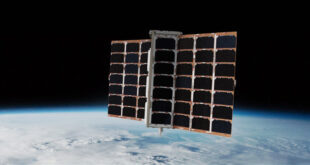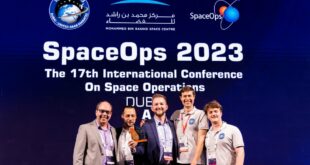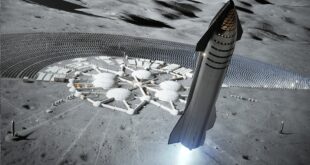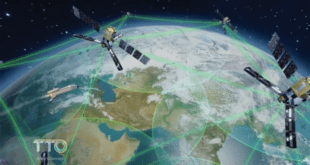D-Orbit has signed a 26-million-euro contract with the European Space Agency (ESA) for IRIDE, a space-based observation program from the Italian Government. It will leverage national competencies and responsibility with the support of ESA, which will manage the project and the Italian Space Agency (ASI) under the framework of Italy’s National Recovery and Resilience Plan (PNRR).
Read More »Spire Global Awarded Contract for Radio Frequency Data
Spire Global, a space-to-cloud data and analytics company based in Virgina US, announced on the 3rd of April that they have been awarded a contract by the National Reconnaissance Office (NRO) for commercial radio frequency (RF) remote sensing. This contract is part of the NRO’s Strategic Commercial Enhancements (SCE) Broad Agency Announcement (BAA) program in September 2022.
Read More »SDA Successfully Launches Tranche 0 Satellites
The Space Development Agency (SDA) has announced the successful initial launch of Tranche 0 (T0) of the Proliferated Warfighter Space Architecture (PWSA). These will make up the Transport and Tracking Layer satellites that demonstrate the low-latency communication links to support the warfighter with a resilient network of integrated capabilities, including tracking of advanced missile threats from low-Earth orbit (LEO).
Read More »Kenya Space Agency to Launch First Operational 3U EO Satellite
The Kenya Space Agency (KSA) has announced its intention to launch Kenya's first operational 3U Earth Observation Satellite, Taifa-1 ("one nation" in Swahili) satellite, on April 11, 2023. The launch, through SpaceX, will take place in Vandenberg Base, California, UDA aboard Falcon-9 Rocket. Kenyan engineers from SayariLabs constructed and designed the Taifa-1, while EnduroSat aided in the testing and manufacturing of the parts. To this end, EnduroSat organized a two-week educational training for SayariLab’s engineering team, dedicated to space systems and engineering, covering all aspects of mission analysis, design, and spacecraft assembly.
Read More »Register Today for our Space Café “33 minutes about the Lunar Policy Handbook” on 11 April 2023
This Space Café WebTalk will feature Héloïse Vertadier and Christopher Johnson in a conversation with Torsten Kriening about "Lunar Policy Handbook: Guiding Responsible and Sustainable Development of the Moon". This document is a reference guidebook for government personnel and private actors in the space industry. It is designed to be a high-level guide that is useful for a broad audience of space actors, outlining policy issues and operational considerations related to lunar activities.
Read More »OPS-SAT Flying Laboratory Wins 2023 SpaceOps Award
The OPS-SAT Mission Control Team has received its trophy after winning the 2023 International SpaceOps Award for Outstanding Achievement. The award recognizes the team’s outstanding achievement in creating and operating the world’s first mission dedicated to improving space operations by allowing rapid experimentation of mission-critical processes in an open, flying laboratory. It is the first time that an ESA-only operating mission has won the award since its inception in 2006.
Read More »ClearSpace and LeoLabs Partner for Safer Space Environment
ClearSpace and LeoLabs have signed a Memorandum of Understanding recognizing their shared vision for a safe and sustainable space ecosystem and their mutual efforts in making this vision a reality. The partnership signals a desire to build on this mutual success and previous collaborative efforts, such as the joint LEO Kinetic Space Safety Workshop in May 2022. The MOU also serves as a formal declaration of ClearSpace and LeoLabs’ intent to work together on several new initiatives.
Read More »#SpaceWatchGL Opinion: Creating a Commercial Space-Based Solar Power Industry
The idea of space-based solar power has been around since the 1960s, but recently gained new momentum. While we already use solar power today on Earth, there are a few drawbacks to putting solar panels on our rooftops or fields. The most important is the intermittent nature of Earth-based solar power, as its power generation fluctuates during the day - and goes down to zero at night. In addition, to compensate for this intermittency and the low load factor (appx. 11 % yearly average), large areas of land have to be covered with solar power to produce enough energy, and storage or backup capacities are needed for the nights and winter months.
Read More »Intelsat to Operate Air Pollution Monitoring Space Instrument
Intelsat has completed testing of the operational and data collection system for the first space-based instrument to monitor major air pollutants across the North American continent every daylight hour at high resolution. The new UV-visible spectrometer, which Intelsat operates for NASA and the Smithsonian Astrophysical Observatory, will launch on the Intelsat 40e (IS-40e) satellite tentatively next month.
Read More »DARPA to Develop Satellite Monitoring Software Solutions
The Defense Advanced Research Project Agency (DARPA) has selected teams to develop software solutions to constantly monitor up to 1,000 targets of interest via satellite with the Oversight program. This is to help military planners keep track of up to 1,000 targets of interest through the management of available space domain resources
Read More » SpaceWatch.Global An independent perspective on space
SpaceWatch.Global An independent perspective on space










